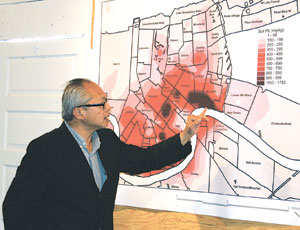A proposal by a North Carolina artist is laying the foundation for what may become the largest in-situ residential soil-lead remediation project in the country. Artist Mel Chin’s work often brings site-specific art to unlikely places, including destroyed homes and landfills. He has worked with scientists in the past to create gardens of hyperaccumulators—plants that draw heavy metals from soil. Now he is attracting academic, engineering and social resources to ask Congress for $300 million to address soil-lead contamination in New Orleans.

Although the contamination is not attributed to Hurricane Katrina’s floods in 2005, the federal Environmental Protection Agency’s intensive post-disaster analysis of soil conditions there has created an unusually detailed picture of the city’s lead-contamination problem. An estimated 86,000 city lots have soil-lead concentrations of more than 400 parts per million—six times EPA’s maximum for lead in play-area soil.
EPA says the lead is from flaking paint of older homes, but Howard Mielke, a scientist at the Tulane/Xavier Center for Biomedical Research, says about half comes from leaded-gasoline dust still in the air. He estimates up to 30% of the city’s children suffer from lead poisoning. In 2004, Mielke won a $700,000 federal grant to cap 25 local lots with 6-in. of alluvial sand. A year later soil lead levels in one neighborhood dropped from 1,279 mg per kg to 4.1. Levels remain low, even after Katrina’s floods.
Chin also proposes a 6-in. sand cap but only after mixing ¾ ton of Apatite II, a fish-bone-derived phosphate, into the top 6-in of a standard 25-ft-by-50 ft New Orleans lot. The slow-leeching additive binds to the lead, making it indigestible, says Andrew Hunt, an environmental researcher at the University of Texas. Gina Solomon, a Natural Resources Defense Council scientist who helped develop the Apatite II treatment about a decade ago, says Chin’s project is “exactly the ticket” for inclusion in a national infrastructure reconstruction plan.

Post a comment to this article
Report Abusive Comment